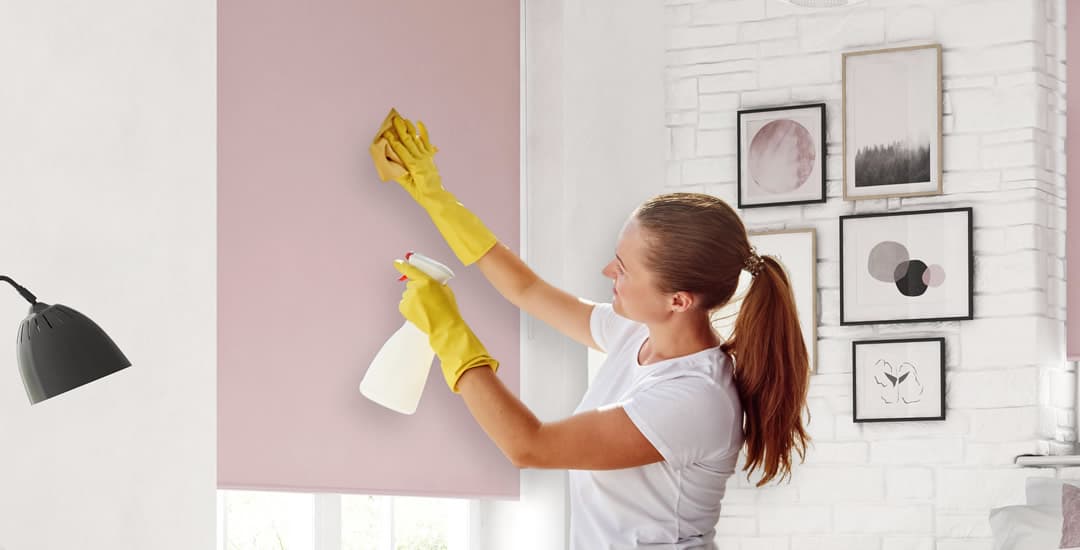
Roller blinds are the most popular window blinds of all, and PVC or vinyl roller blinds in particular are well suited to kitchens and bathrooms as they’re waterproof and won’t get damaged by moisture and humidity.
Generally, cleaning roller blinds in rooms that aren’t humid simply involves dusting or vacuuming them regularly; but blinds in bathrooms or kitchens, and sometimes other rooms too, may get marks and stains on them or even potentially grow their own colony of mould if they’re exposed to damp.
If your roller blinds have stains or mould on them and you’ve already had a go at giving them a rather more robust cleaning following the directions in this blog post about how to clean roller blinds without success, worry not.
Read on and I will tell you how to remove stains from roller blinds, or if your blind has started to develop a new lifeform that you’ve already christened “The Ick,” how to remove mould from roller blinds too.
How to remove stains from roller blinds
If your roller blinds have stains on them that warm, soapy water alone isn’t shifting, you might find more success using a fabric stain remover instead. However, take care to ensure that this doesn’t contain bleach (to avoid discolouring the fabric) and read the instructions on the packaging first to make sure it is safe for the fabric your blinds are made of.
Virtually all roller blinds will be made of either polyester, PVC, or vinyl, with polyester requiring a little more caution in terms of approach. You’ll almost certainly be able to tell from the feel of it if your blinds are PVC or vinyl, which are a bit more robust; but still, don’t go overboard as you can still potentially damage the fabric.
Use a sponge or an old toothbrush to scrub gently at the stains, and try to follow the direction of the fabric’s weave to avoid leaving marks afterwards.
How to remove mould from roller blinds
Before you begin, consider covering your mouth and nose to avoid inhaling the mould spores when you start disturbing them.
- Start by dry-brushing affected areas of the blind (using an old toothbrush for small areas or a soft-bristled scrubbing brush for larger patches) to remove surface spores.
- Spot-treat affected areas of the blind with a fabric-safe detergent that is designed to kill mould spores, diluted according to the manufacturer’s directions. Alternatively, try a mixture of lemon juice and white vinegar if you can’t lay your hands on an appropriate detergent or want a more natural way to clean window blinds.
- Treat polyester roller blind fabrics gently; if your blinds are made of PVC or vinyl, these are more mould-resistant than polyester blinds, but also tend to be less keen to hang onto mould as well, and black mould on roller blinds of this type can often just be wiped off.
- If you find that this is not the case, you can scrub PVC or vinyl blinds with a lot more enthusiasm than you can polyester ones, as long as you use a soft brush to ensure that the bristles will not score or even piece the fabric.
Can you dry clean roller blinds to remove mould or stains?
If your blinds are really stained or mouldy and you have cleaned them as best you can with limited success, roller blinds can actually be dry cleaned to definitively kill mould spores and bacteria and to remove all but the most stubborn of stains too. That said, not all dry cleaners offer this service and so you may have to shop around.
Can you prevent mould from growing on blinds?
If you’re looking to buy new blinds for a kitchen or bathroom, picking PVC or vinyl materials is a wise choice as they are waterproof and also fungal-resistant, making blinds of this type well suited to humid or moist environments and less likely to get mouldy from exposure to damp.
However, you can prevent or limit the chances of mould growing on roller blinds of any type by keeping damp, moist rooms well ventilated (opening a window or using a dehumidifier after cooking or bathing to clear condensation on the window and humidity in the air, for instance). If your blinds get splashed or otherwise wet, pat or wipe them off with a towel and roll them down to allow them to air dry fully.
You can even use a hairdryer on the “cool” setting to speed the drying process up, but try to aim for airflow rather than heat, as applying concentrated heat to your blinds can cause damage the fabric.




